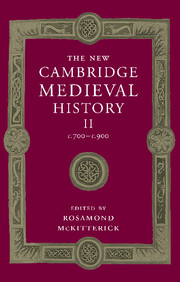Book contents
- Frontmatter
- PART I POLITICAL DEVELOPMENT
- PART II GOVERNMENT AND INSTITUTIONS
- PART III CHURCH AND SOCIETY
- 21 The papacy in the eighth and ninth centuries
- 22 The organisation, law and liturgy of the western church, 700–900
- 23 Carolingian monasticism: the power of prayer
- 24 Religion and lay society
- PART IV CULTURE AND INTELLECTUAL DEVELOPMENTS
- Conclusion
- Appendix genealogical tables
- List of primary sources
- Bibliography of secondary works arranged by chapter
- Index of manuscripts
- General index
- Frontispiece">
- Plate section
- Map 4 Charlemagne’s Europe and Byzantium, 814
- Map 19 The ecclesiastical provinces of western Europe 700-900
- Map 20 Carolingian schools, scriptoria and literary centres
- Genealogical table X: Wessex
- References
24 - Religion and lay society
from PART III - CHURCH AND SOCIETY
Published online by Cambridge University Press: 28 March 2008
- Frontmatter
- PART I POLITICAL DEVELOPMENT
- PART II GOVERNMENT AND INSTITUTIONS
- PART III CHURCH AND SOCIETY
- 21 The papacy in the eighth and ninth centuries
- 22 The organisation, law and liturgy of the western church, 700–900
- 23 Carolingian monasticism: the power of prayer
- 24 Religion and lay society
- PART IV CULTURE AND INTELLECTUAL DEVELOPMENTS
- Conclusion
- Appendix genealogical tables
- List of primary sources
- Bibliography of secondary works arranged by chapter
- Index of manuscripts
- General index
- Frontispiece">
- Plate section
- Map 4 Charlemagne’s Europe and Byzantium, 814
- Map 19 The ecclesiastical provinces of western Europe 700-900
- Map 20 Carolingian schools, scriptoria and literary centres
- Genealogical table X: Wessex
- References
Summary
dominated by the establishment of the Carolingian empire and the extension of its political and religious influence beyond the imperial frontiers, the centuries from 700 to 900 witnessed a vigorous effort by ecclesiastical authorities to transform the religious life of the laity. Influenced by ideals originating in monastic and missionary circles, ideologues at the Carolingian court set out to establish a comprehensive code of conduct for the laity and a firm place for them within the Christian church. Reformers concentrated on encouraging education in the basic tenets of Christian doctrine, channelling lay people’s spiritual needs into directions approved by the upper echelons of the clerical hierarchy and imposing a Christian moral code formulated for those in secular occupations. In so doing, clergy (often themselves from a monastic background) encountered beliefs, practices and social customs of which they disapproved. From lay people’s point of view, the rituals of the Christian church in which they were encouraged – or coerced – to participate were often only one of a number of possible ways of making sense of the world, placating its hostile forces and ensuring social harmony. When men and women did follow preachers’ exhortations, they may have seen a significance in their actions that differed from what the clergy hoped to inculcate. The religion of lay society c. 700–900 by no means always conformed to the ideal which the ecclesiastical establishment struggled to impart.
Keywords
- Type
- Chapter
- Information
- The New Cambridge Medieval History , pp. 654 - 678Publisher: Cambridge University PressPrint publication year: 1995
References
- 1
- Cited by

